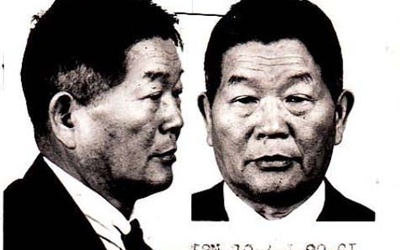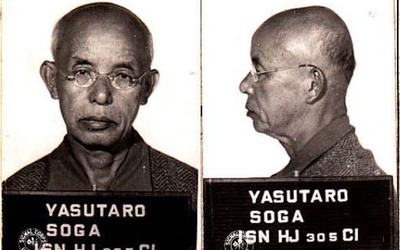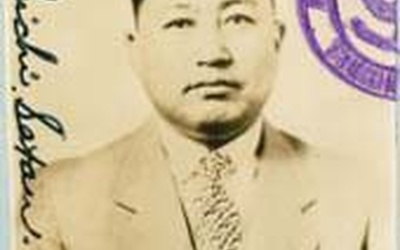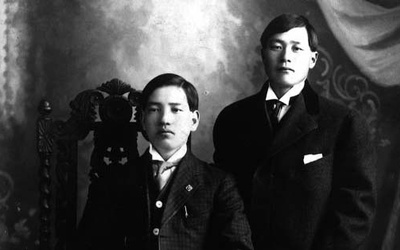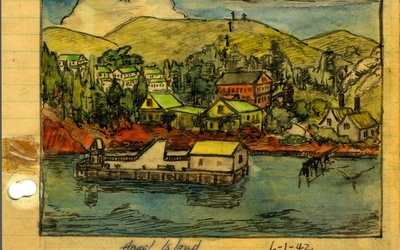Internment of Japanese Americans on Angel Island during World War II
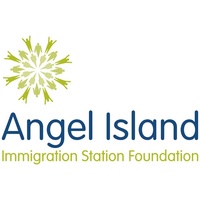
Angel Island Immigration Station Foundation (AIISF), thanks in large part to a grant from the Japanese American Confinement Sites program of the National Park Service, has researched the story of the 700+ Americans of Japanese descent who were arrested by the FBI in Hawaii and the West Coast after Pearl Harbor and spent some time on Angel Island. AIISF’s webpage with more history is online. The immigration station processed about 85,000 Japanese immigrants from 1910 to 1940, but during World War II was a temporary internment facility operated by the Army’s Fort McDowell. Most internees spent three weeks or fewer on the island. From there, the internees were sent to Department of Justice and US Army camps such as Missoula, Montana; Fort Sill, Oklahoma; and Lordsburg and Santa Fe, New Mexico.
This series includes stories of internees with information from their families and the National Archives and Records Administration in College Park, MD. If you have information to share about former internees, please contact AIISF at info@aiisf.org.
Stories from this series
Rev. Asataro Yamada's Detention on Angel Island Due to His Religious Practices
May 29, 2015 • Grant Din
Born in Aki-gun, Japan in 1878, Asataro Yamada first came to the United States in 1898 into the port of Seattle at a time when there were few restrictions on Japanese immigration. He then worked as a sailor for many years on ships that sailed all over the Pacific. He worked as a farm laborer, ran his own hardware store in Seattle, sold Chevrolet cars, and taught people from Japan how to drive, according to his grandson Byron Ishiwata. He …
Journalist Yasutaro Soga’s Detention on Angel Island During World War II
May 14, 2015 • Grant Din
Japanese immigrants were arrested by the FBI on both the mainland U.S. and the islands of the Territory of Hawaii on December 7, 1941 and in the following months. By law they were “enemy aliens” and could be taken away as internees. As mentioned elsewhere on our site, Asians could not become U.S. citizens, by law. One of these immigrants was Yasutaro Soga, editor of a Japanese language newspaper in Honolulu. He and several hundred other prominent Issei (Japanese immigrants) …
Chokichi Satow – “Double Angel” Detained on Angel Island at Least Twice
May 5, 2015 • Grant Din
Satow was born in Miyagi-ken, Japan on January 15, 1885. He first arrived in San Francisco in 1903, before Angel Island became a U.S. immigration center, later returned to Japan, and then re-entered the U.S. in 1928 and 1931, when he was questioned on Angel Island. As a returning immigrant who had originally arrived before the restrictions of the 1917 and 1924 immigration laws took effect, he was allowed to return to the U.S. Satow worked many jobs to make …
Angel Island Was One of Eight Detention Centers for Otokichi Ozaki
April 27, 2015 • Grant Din
Ozaki was born November 3, 1904 in Kochi-ken, Japan, and came to Hawaiˋi on April 24, 1917. Otokichi married Hawaiˋi-born Hideko Ozaki, and they had four children aged two to eight when World War II broke out. He was one of several hundred Japanese immigrants in the Territory of Hawaiˋi to be arrested, and then was sent to eight different internment camps. His book captures his and his family’s experiences through letters, poetry, and later radio broadcasts that he gave …
Mantsuchi and Sojuro Nakamura: Japanese Immigrant Farmers in California’s Central Valley
April 15, 2015 • Grant Din
Mantsuchi Nakamura was born on February 27, 1877 in Hiroamachi, a small village in Yamaguchi-ken on the isolated Yanai Peninsula of western Honshu, during the time of the Meiji emperor. He was the eldest of seven children. His granddaughter-in-law, Katherine Peters Yamada, notes that many of the people in this region were quite poor in the late 1800s. Despite its isolated location, 420 men from Yamaguchi-ken responded to contractors from the Hawaiian government who were recruiting Japanese laborers for the …
The Hoshidas’ Journeys Through Angel Island during World War II
April 6, 2015 • Grant Din
George Yoshio Hoshida was arrested and detained on February 6, 1942. Information in his file at the National Archives and Records Administration in College Park, MD notes that he was a member of the Kilauea Central Japanese Association, United Young Buddhist Association (YBA), and the Waiakea Houselots Association. A confidential informant noted that believed Hoshida was “pro-Japanese” because he was a treasurer for the Hawaii Budo Kyo Kai, a judo association and due to his involvement with the YBA. In …

